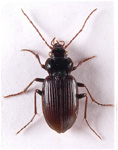A careful count of tarsal segments will eliminate most species likely to be confused with Carabids. Omaliine Staphylinids, where the elytra almost cover the abdomen and may do so completely in carded specimens, possess distinct ocelli.
Pterostichus madidus (Fab.), very likely to be encountered almost immediately by anybody embarking upon a study of Coleoptera, is as typical a Carabid as any. Some idea of the range of variation is given below but there also specialised forms e.g. Omophron, Cicindela and Calosoma.
Found in most situations; arable land and pasture, moors and heaths, many species under bark and logs in woodland and often huge numbers among waterside vegetation. At least two species, Oodes helopoides and Carabus clathratus live underwater among vegetation. Pitfall trapping is usually very productive, searching parkland pathways with a torch on warm spring and summer evenings can reveal large numbers. M.V. light on a vertical sheet and interception nets often give good results.
For an excellent discussion of Carabid biology and ecology see Forsythe, 2000
Farrow, R.A. and Lewis, E.S. 1971 Ent.Mon.Mag. (1970) 106:219-221
Images
Images
Images
Images
Omophron
limbatum
Cicindela
campestris
Cylindera
germanica
Cylindera
germanica
Brachinus
Carabus
granulatus
Carabus
nemoralis
Carabus
nemoralis
Carabus
problematicus
Carabus
violaceus
Carabus
violaceus
Cychrus
caraboides
Cychrus
caraboides
Cychrus
caraboides
Leistus
fulvibarbis
Leistus
spinibarbis
Nebria
brevicollis

Nebria
brevicollis
Nebria
brevicollis
Nebria
brevicollis
Nebria
salina

Notiophilus
aesthuans

Notiophilus
aquaticus

Notiophilus
biguttatus
Notiophilus
biguttatus
Notiophilus
biguttatus
Notiophilus
biguttatus
Notiophilus
biguttatus

Notiophilus
germinyi

Notiophilus
palustris
Notiophilus
palustris

Notiophilus
quadripunctatus

Notiophilus
rufipes

Notiophilus
substriatus

Elaphrus
cupreus
Elaphrus
cupreus
Elaphrus
cupreus
Elaphrus
cupreus
Elaphrus
cupreus

Elaphrus
lapponicus
Elaphrus
riparius
Elaphrus
riparius
Elaphrus
riparius

Elaphrus
uliginosus
Loricera
pilicornis
Loricera
pilicornis
Loricera
pilicornis
Loricera
pilicornis
Clivina
fossor
Clivina
fossor
Clivina
fossor
Broscus
Trechus
quadristriatus
Trechus
quadristriatus
Perileptus
Thalassophilus
Asaphidion
curtum
Asaphidion
curtum
Bembidion
articulatum
Bembidion
articulatum
Bembidion
articulatum
Bembidion
biguttatum
Bembidion
biguttatum
Bembidion
biguttatum
Bembidion
dentellum
Bembidion
dentellum
Bembidion
dentellum
Bembidion
dentellum
Bembidion
dentellum
Bembidion
doris
Bembidion
guttula
Bembidion
lampros
Bembidion
lampros
Bembidion
lampros
Bembidion
lunulatum
Bembidion
lunulatum
Bembidion
lunulatum
Bembidion
obtusum
Bembidion
quadrimaculatum
Bembidion
tetracolum
Bembidion
tetracolum
Bembidion
tetracolum
Bembidion
tetracolum
Bembidion
varium
Ocys
harpaloides
Ocys
harpaloides
Ocys
harpaloides
Pogonus
Patrobus
atrorufus
Abax
parallelepipedus
Abax
parallelepipedus
Poecilus
cupreus
Poecilus
cupreus
Poecilus
versicolor
Pterostichus
cristatus
Pterostichus
madidus
Pterostichus
madidus
Pterostichus
madidus
Pterostichus
madidus
Pterostichus
madidus
Pterostichus
melanarius
Pterostichus
melanarius
Pterostichus
minor
Pterostichus
niger
Pterostichus
niger
Pterostichus
niger
Pterostichus
niger
Pterostichus
niger
Pterostichus
nigrita
Pterostichus
nigrita
Pterostichus
nigrita
Pterostichus
oblongopunctatus
Pterostichus
strenuus
Stomis
pumicatus
Calathus
fuscipes
Calathus
fuscipes
Calathus
fuscipes
Calathus
fuscipes
Calathus
fuscipes
Calathus
melanocephalus
Calathus
rotundicollis
Calathus
rotundicollis
Calathus
rotundicollis
Calathus
rotundicollis
Platyderus
depressus
Agonum
marginatum
Agonum
muelleri
Agonum
thoreyi
Agonum
thoreyi
Agonum
thoreyi
Anchomenus
dorsalis
Paranchus
albipes
Paranchus
albipes
Paranchus
albipes
Paranchus
albipes
Platynus
assimilis
Amara
aenea
Amara
aenea
Amara
aenea
Amara
aenea
Amara
aenea
Amara
apricaria
Amara
bifrons
Amara
bifrons
Amara
bifrons
Amara
communis
Amara
communis
Amara
convexior
Amara
convexior
Amara
familiaris
Amara
lunicollis

Amara
ovata
Amara
plebeja
Amara
plebeja
Amara
plebeja
Amara
plebeja
Amara
plebeja
Amara
similata
Curtonotus
aulicus
Curtonotus
aulicus
Zabrus
tenebrioides
Acupalpus
dubius
Acupalpus
dubius
Acupalpus
exiguus
Acupalpus
meridianus
Acupalpus
meridianus
Acupalpus
parvulus
Anthracus
consputus
Bradycellus
verbasci
Harpalus
affinis
Harpalus
affinis
Harpalus
affinis
Harpalus
affinis
Harpalus
affinis
Harpalus
latus
Harpalus
rubripes
Harpalus
rufipes
Harpalus
rufipes
Harpalus
rufipes
Ophonus
ardosiacus
Ophonus
puncticeps
Ophonus
puncticeps
Ophonus
rufibarbis
Ophonus
rufibarbis
Ophonus
rufibarbis
Ophonus
rufibarbis
Ophonus
rufibarbis
Stenolophus
mixtus
Trichocellus
placidus
Chlaenius
vestitus
Oodes
helopioides
Badister
bullatus
Panagaeus
bipustulatus
Demetrias
atricapillus
Demetrias
atricapillus
Demetrias
atricapillus
Dromius
quadrimaculatus
Dromius
quadrimaculatus
Dromius
quadrimaculatus
Lebia
chlorocephala
Microlestes
minutulus
Paradromius
linearis
Syntomus
foveatus
Syntomus
foveatus
Syntomus
foveatus
Syntomus
obscuroguttatus
Syntomus
obscuroguttatus
Syntomus
obscuroguttatus
Odacantha